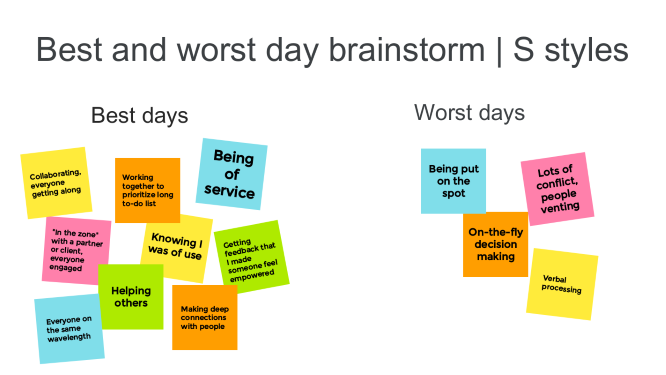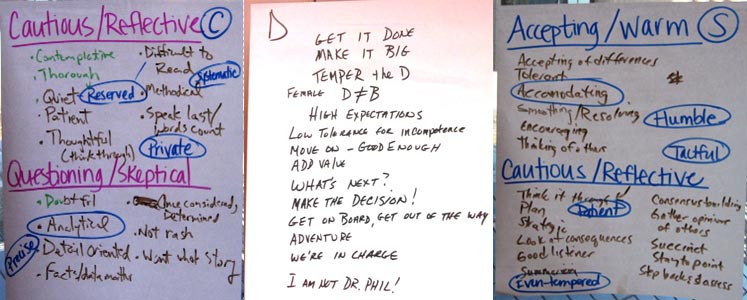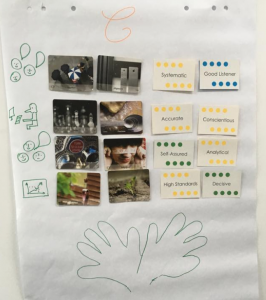Day in the life - DiSC activity
Build a foundation for the DiSC styles
This is appropriate for Everything DiSC® and DiSC® Classic profiles.
Objective: Introduce DiSC styles and provide concrete examples of how those styles influence our daily lives. Often this activity also provides opportunities to point out that not everyone with the same style behaves the exact same way and explore the danger of pigeonholing people into their styles.
Materials: Whiteboards (physical or virtual) or flip charts
Time required: ~90 minutes
Instructions:
- Divide the group into their primary DiSC styles.
Tip: If a style is not represented, move people with that secondary style to that group, if possible, and join it yourself to better guide their discussion. - Pose the simple instruction: “Create a poster (or add notes to a shared virtual board) that reflects a 'Day in the life' of your style: D, i, S, or C.”
Tip: Suggest questions they can answer based on your goals for this group:- What's your first thought of the day?
- What makes it a great day? A bad day?
- How can we learn to best relate to you?
- How are you often misunderstood?
- What are your fears?
- What's most likely to drive you crazy during a work day?
- What are the contributions you bring to a team/organization?
- What do you enjoy most or find most difficult about working remotely?
- Allow 10 minutes for the groups to work together on their posters.
- Have each group teach the other groups what they captured on their poster.
Tip: Allow the group to own their contributions, words, and expressions. Step in only if something said is vastly incorrect for that style and the comment may be more aligned with group members' secondary styles than their primary style. Acknowledge how difficult it is sometimes to tease apart primary vs. secondary styles or an extra priority. - After each group presents their poster, request “teach-backs,” where listeners repeat back what they learned. Be prepared to ask questions if the group struggles. Highlight or repeat words or descriptions that are particularly good and clear for that style.
Tip: Keep a DiSC style word list with you for reference.
D: direct, firm, strong-willed, forceful, results-oriented
i: outgoing, enthusiastic, optimistic, high-spirited, lively
S: even-tempered, accommodating, patient, humble, tactful
C: analytical, reserved, precise, private, systematic - Ask follow-up questions such as these:
- How do each style's posters differ? Are there differences beyond text? (drawings, lists, wordiness, color, volume of text)
- Did each group work together in the same way? (how they decided who would write/draw, how long it took them to put something on the chart, which group volunteered to go first)
- After each group has shared, wrap it up by going around to each poster and adding the “Get it Factor” or the main motivation for each style.
D: Get it Done
i: Get Recognition or Approval
S: Get Along
C: Get it Right
- Facilitate a discussion of the strengths of each style and ask for examples of how they've seen these displayed. When does their team need each strength most? What are some examples of when or how they have had to stretch into another style of behavior to accomplish a goal?
- Thank everyone for their willingness to share and for their insights.
Additional activity on overuse of strengths
Strengths, if relied on too often, can sometimes turn into challenges or limitations.
- Ask everyone to visit the posters not reflective of their style and place a dot (or make a mark) next to traits or actions they've seen overused or as a limitation.
- Once everyone has returned to the main group, ask for examples of observable behaviors that show how a marked item has been a limitation or barrier. What does “overly analytical” really look and feel like to non-Cs, for example? When does the group welcome and value deep analysis? When do they prefer less? Allow enough time for discussion.
Adaption for use with Everything DiSC Management
Ask the group to explore a day in the life of a manager and ask these questions:
- How does your management style contribute to your organization?
- What are your management challenges as a D, i, S, or C?
- How have you been misunderstood as a manager (by direct reports or more senior management)?
- What would your direct reports say is something you avoid or neglect that would make you a better manager? (This might be another style you need to learn to flex into.)
- What would you like to learn from another style?
Board and flip chart samples
Here are a few sample completed charts. You'll find more on Pinterest. Some facilitators like to start the posters with some guiding text. Sometimes you'll find a group will want to draw everything rather than write anything.
On a virtual whiteboard (e.g., Jamboard):

On flip charts:

Using cards from the QuikDiSC set and images:

Follow-ups
Did your learners create posters during a Day in the Life or other activity? Share a photo or screen capture of each of these. Ask one or two of the following questions; answers can be shared with others or simply reflected upon.
- How have you observed these examples in the last week?
- How have you kept the differing styles in mind when writing, during meetings, or when planning?
- Is there someone whose needs or priorities probably aren’t being met on your team?
- After reviewing these posters, is there anything else you’d like to share or discuss with your colleagues?
Telling your DiSC story (works well as a follow-up activity)
People-reading with Everything DiSC (learning hub post)
Common Sayings and DiSC Quiz (PowerPoint deck)
DiSC Styles and Dr. Seuss Quotes (PowerPoint deck)
Reviewing DiSC Styles with Lemony Snicket (PowerPoint deck)
Make the Most of Meetings Using Work Style, everythingdisc.com blog

